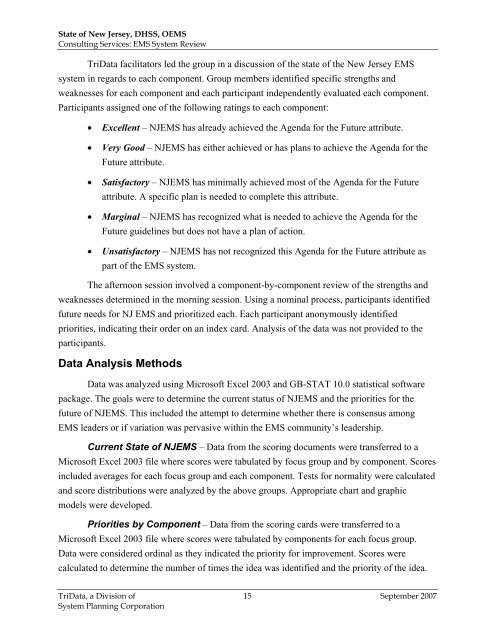EMS System Review - State of New Jersey
EMS System Review - State of New Jersey
EMS System Review - State of New Jersey
- No tags were found...
You also want an ePaper? Increase the reach of your titles
YUMPU automatically turns print PDFs into web optimized ePapers that Google loves.
<strong>State</strong> <strong>of</strong> <strong>New</strong> <strong>Jersey</strong>, DHSS, O<strong>EMS</strong>Consulting Services: <strong>EMS</strong> <strong>System</strong> <strong>Review</strong>TriData facilitators led the group in a discussion <strong>of</strong> the state <strong>of</strong> the <strong>New</strong> <strong>Jersey</strong> <strong>EMS</strong>system in regards to each component. Group members identified specific strengths andweaknesses for each component and each participant independently evaluated each component.Participants assigned one <strong>of</strong> the following ratings to each component:• Excellent – NJ<strong>EMS</strong> has already achieved the Agenda for the Future attribute.• Very Good – NJ<strong>EMS</strong> has either achieved or has plans to achieve the Agenda for theFuture attribute.• Satisfactory – NJ<strong>EMS</strong> has minimally achieved most <strong>of</strong> the Agenda for the Futureattribute. A specific plan is needed to complete this attribute.• Marginal – NJ<strong>EMS</strong> has recognized what is needed to achieve the Agenda for theFuture guidelines but does not have a plan <strong>of</strong> action.• Unsatisfactory – NJ<strong>EMS</strong> has not recognized this Agenda for the Future attribute aspart <strong>of</strong> the <strong>EMS</strong> system.The afternoon session involved a component-by-component review <strong>of</strong> the strengths andweaknesses determined in the morning session. Using a nominal process, participants identifiedfuture needs for NJ <strong>EMS</strong> and prioritized each. Each participant anonymously identifiedpriorities, indicating their order on an index card. Analysis <strong>of</strong> the data was not provided to theparticipants.Data Analysis MethodsData was analyzed using Micros<strong>of</strong>t Excel 2003 and GB-STAT 10.0 statistical s<strong>of</strong>twarepackage. The goals were to determine the current status <strong>of</strong> NJ<strong>EMS</strong> and the priorities for thefuture <strong>of</strong> NJ<strong>EMS</strong>. This included the attempt to determine whether there is consensus among<strong>EMS</strong> leaders or if variation was pervasive within the <strong>EMS</strong> community’s leadership.Current <strong>State</strong> <strong>of</strong> NJ<strong>EMS</strong> – Data from the scoring documents were transferred to aMicros<strong>of</strong>t Excel 2003 file where scores were tabulated by focus group and by component. Scoresincluded averages for each focus group and each component. Tests for normality were calculatedand score distributions were analyzed by the above groups. Appropriate chart and graphicmodels were developed.Priorities by Component – Data from the scoring cards were transferred to aMicros<strong>of</strong>t Excel 2003 file where scores were tabulated by components for each focus group.Data were considered ordinal as they indicated the priority for improvement. Scores werecalculated to determine the number <strong>of</strong> times the idea was identified and the priority <strong>of</strong> the idea.TriData, a Division <strong>of</strong> 15September 2007<strong>System</strong> Planning Corporation



